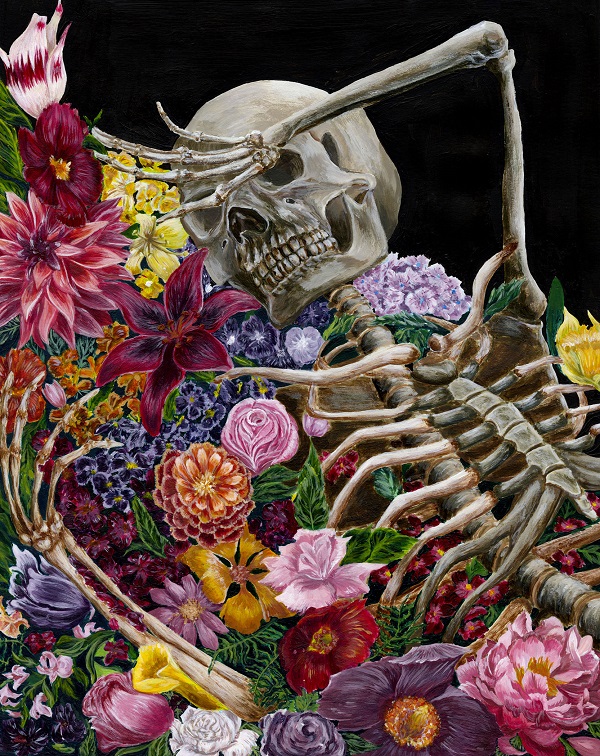Freed from ED
Illustrated by Jenny Bien-Aimé
Entropy is about the relationship and process of moving from order to disorder and, with more difficulty, vice-versa. But what is considered orderly and disordered? For instance, actions that appear ordered might have the opposite effect. Similarly, attempts to get life in order can end up in disorder.
What do you think when you read the word “anorexia”? High fashion models? Crazy teenage girls? Another diet? The latest Lilly Collins movie?
How about a ten-year-old girl that ended up on a life-long journey of recovery?
 Eating disorders are considered addictions, but unlike the addict, who can abstain from the substance, I can’t. I must face both, my fear and my “drug”, every 2-5 hours, everyday.
Eating disorders are considered addictions, but unlike the addict, who can abstain from the substance, I can’t. I must face both, my fear and my “drug”, every 2-5 hours, everyday.
Unlike the common belief, eating disorders are not “just diets”. They are not just teenage “phases” or insecurities caused by the Victoria Secret’s catalogue. They are serious mental illnesses which affect at least 30 million people in the U.S. alone. Anorexia Nervosa, which is what I was diagnosed with, is the NUMBER ONE cause of death among all mental illnesses. These diseases not only occur among young women. They come in all shapes and sizes. Eating disorders are not just bulimia and anorexia, and they’re not mutually exclusive. The overwhelming majority develops a mix of them, ranging from restrictive anorexia, to binge eating, to bulimia, bigorexia, orthorexia, and EDNOS. Unfortunately, eating disorders don’t discriminate. They cross all gender, nationality, race, and age barriers and affect people all over the world.
But what does a real eating disorder look like? It doesn’t look like a magazine cover girl in a bikini. Nor does it look like flat stomachs and thigh gaps. It’s not about having the “will power” to resist eating a piece of cake or fitting into the smallest skinny jeans. Eating disorders look like shame and misery. My eating disorder looks like 8 years of constant battle against myself. It looks like fights over how filled a cup of Special K should be. It looks like meal plans, midnight weigh-ins, lies and cries. It looks like wearing kid-sized sweat pants and 3 sweaters to hide every sticking bone in my body. It’s feeling ashamed of my thinness, but still striving for more. It looks like putting coins in my bra to try to weigh a bit more with my nutritionist or like adding calories in class instead of adding the math work assigned. It is overwhelming anxiety, mixed with paralyzing depression, which translates to wanting to lie in bed and die, but doing jumping jacks instead, because I “might get fat”.
With all the shame in the world, I look into my family’s eyes and apologize once again for all the mistakes I made. But despite my pain, I know that I wasn’t myself. I couldn’t control my impulses, I couldn’t stop. Anorexia took over my mind, my body, and my soul. I was a bag of bones, a ghost walking in the hallways, doing crunches all night long.
I thought I would only lose weight, but instead, I lost myself. I lost my friends, I lost my family’s trust, I lost my body, my period, my hunger, my memory, my time, my growth. I lost my will to live, and slowly but steadily, I decided to starve myself to death. But despite all of the negative aspects of my disease, I can see that in some way, my eating disorder was a necessity, as it was the only way I knew to cope with my pain.
There’s no specific cause of an eating disorder. They are the result of a mix of biological, psychological, and sociological factors which, together with a specific personality type, make the right conditions for an eating disorder to develop. There’s no one to blame, there’s no traumatic experience required, and there’s not one specific cure either. Eating disorders, like addictions, are coping mechanisms one develops in an attempt to survive in a world where one feels rejected. In addition to predisposing genes and sociocultural pressures, eating disorders are a way to fill in the void of not feeling good enough.
I cannot count the regrets I have, but neither can I bring back time. I can only thank those who stood and still stand by me, even if they couldn’t understand why a couple of carrots made me cry.
In these eight years, I’ve learned to love myself and to accept the parts of my soul that no one else ever will. We all have shadow selves, and it is not until you make peace with your darkness that you’ll be able to see your light.
With such a stigmatized disease, it is hard to explain to others how, when I isolated myself, it wasn’t because I didn’t like them, but because “Ana” made me do it. It is hard to explain why I “fear” a certain food and how the fear is real. It is hard to explain that eating disorders are not choices, but that it is only through one’s choice that one can recover. It’s hard to explain to my vegan friends how, if I attempt going organic or vegetarian, I’m most likely to end up with in an obsessive cycle. And it’s even harder to live in fat-phobic world, in which it is assumed that everyone is looking to lose weight. But still, I stand and fight, because I know I cannot heal alone, and by showing strength through my vulnerability, I can help others overcome their silent disease and love themselves without any shame.

Comments
No comments posted yet.
You have to be registered and logged in in order to post comments!